Foundation Studies: Contemporary Music Education in India
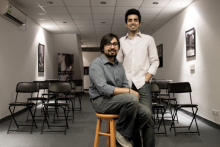
For the past three months, I’ve been in Delhi undertaking a research project on live Indian music. While some research – notably that of Peter Kvetko and Peter Manuel – has discussed the formally distributed Indipop, and other research has occurred on Sufi rock and the music of Bollywood, the live scene has remained relatively academically undisturbed. The coming-across of an undisturbed research area is, of course, irresistible to academics, and so, with the support of my then-affiliated institution, Southern Cross University in Australia, I arranged a field trip to study both the music and the way contemporary music is taught in India.
Discussions on popular music in India can be occasionally confusing to both interviewee and interviewer. Some Indians talk (correctly) of popular music as being the music that accompanies the music of the Indian film industry colloquially referred to as Bollywood. This is the music that is familiar to a large proportion of the Indian citizenry, and that pours from chai stands, some of the fancier autorickshaws, and dance clubs. It is sung in Hindi and typically uses EDM aesthetics. While I was in Delhi, I witnessed a large open-air concert where Bollywood stars mimed to playback singers for a large cheering crowd. It felt like an open-air rock concert. This was very different to the small venues and audiences I observed in Indian rock venues.
The music that we in the west know as “popular” music is also performed, but is more of a niche market. For clarity’s sake, I refer to this as Indian rock, although the variety of genres exceed mere rock, incorporating jazz, blues, psychedelia, reggae and ska, and other influences. However, genre is less defined in India, as the modern industry emerged from the Indian college rock festivals of the 1990s, at a time when the western popular music industry was struggling with filesharing and piracy. Thus the Indian music distribution systems never developed the same strict genrefication so important in the west.
India is also an enormous country, both in population and geography. Even the (relatively) short trip from New Delhi to Mumbai is 1400km, and from Kerala in the south to Nagaland in the northeast is close to 4000km. Because of this regional separation, local scenes are quite different. While my field trip concentrated on Delhi, I heard of the variations; of the Bollywood-influenced Mumbai scene, of the home-performance dominated North-East, of the southern metal scene, and so on. The development of multi-city festivals, such as NH7 Weekender, and the development of a street press (especially Rock Street Journal, known locally as RSJ) is, to some extent, introducing the music of different regions to each other.
While rock music has been performed in India since at least the 1960s and jazz performance dates back to the 1930s, a scene that consistently incorporates the composition of songs by local songwriters, rather than performance of western covers, is relatively new. The establishment of Rock Street Journal in the early ‘90s gave impetus to original Indian rock. The establishment of supportive and alternative venues such as blueFROG in Mumbai in 2007 and TLR in Delhi in 2008 further assisted the development of local scenes.
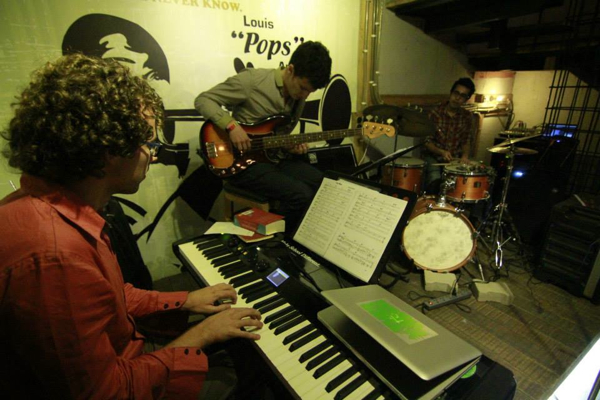
The Tarun Balani Collective play jazz at the Speakeasy in Gurgaon.
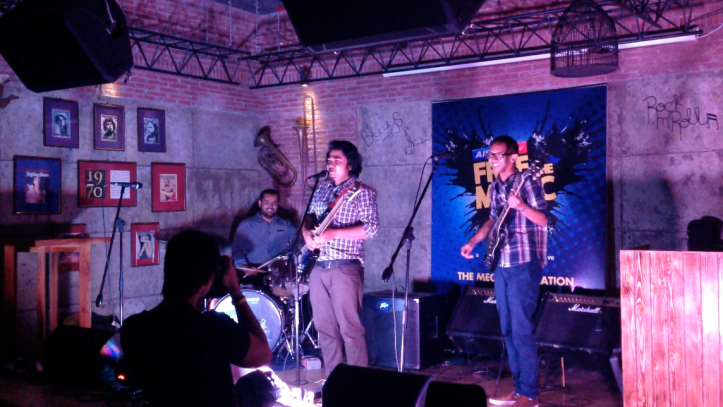
Delhi rock trio Route 3 perform at Turquoise Cottage in Saket.
Echoing the recent development of the live scene, institutions that teach courses in contemporary music are a relatively recent phenomenon in India. This is not to imply that institutions that teach music in India do not exist. Institutions that teach classical Indian music are relatively common in the traditional academy. The University of Delhi, the top-ranking university in India in 2012, offers pre-bachelors through doctoral qualifications in Hindustani or Carnatic music, as do other high-ranking Indian universities such as Banaras Hindu University and the University of Madras. These courses offer nothing related to western rock, but cater strongly to classical traditions. Further, Calcutta School of Music teaches courses in western art music, but does not cover western rock.
Despite the lack of western music courses, universities have traditionally formed a hotbed of western rock performance. In the 1990s, Manmohan Singh, then the Finance Minister, liberalised the Indian economy, causing a rise in the Indian middle classes, which resulted in a corresponding rise in university enrollments, particularly in areas with solid financial prospects such as medicine, law, finance, and business. With western-leaning Indians forming many of these enrollments, western rock became the dominant musical form on Indian campuses in the 1990s. Reflecting this trend, in the mid-‘90s many universities began to hold competitions that became known as “college rock festivals”; however most bands performed covers. Delhi-based drummer Akshat Naurial recalled that
a lot of time, the crowd didn’t understand what you were playing, or they didn’t care about original music. The crowd formed the paradox here. It was so strange. You were dying to play this festival in front of like 5,000 to 7,000 people who don’t give a shit about your music. Yeah, they didn’t care. It’s like the minute you played a cover that they know, they’d cheer the loudest. But the minute you started playing original, they didn’t really care. (Akshat Naurial, Personal Interview, Delhi, 15 October 2013)
Most of the new bands I talked to in Delhi still form at university. Many are talented songwriters and performers, and perform regularly at festivals and venues across Delhi and interstate. However, these performers do not have access to the highly structured contemporary music education that is commonplace in the west.
This is not to suggest that no formal contemporary music education took place until recently. Throughout urban India, individual teachers maintain teaching practices, sometimes addressing contemporary music as well as rock. Sometimes an entrepreneur will open a teaching practice and employ teachers to teach on their behalf. One such institution is the One World College of Music in Gurgaon, about 30km south of Delhi. Set up by Nidhi Kothari, One World is accommodated in a three-level purpose-built building that incorporates individual teaching studios, a small hall, and a recording studio. Students may undertake a program that includes instrumental classes as well as “electives” in composition, music business, and the like. If students desire some formal recognition, they may undertake the Rockschool graded examinations, which offer a performance or teaching diploma. High-end teaching practices, such as One World, blur the boundary between small teaching practices and larger schools similar to tertiary institutions.
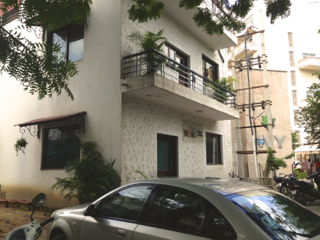
The campus of One World School of Music in Gurgaon.
Some Indian musicians, skeptical of local teachers and from wealthier families, have chosen to attend contemporary music courses overseas. Berklee College of Music in Boston seems to have been a particularly popular destination; however, India was, and is still, a developing country with relatively low salaries (compared to the US), and the course fees for these schools put them out of the financial range of all but the wealthiest Indians. Still, Berklee has maintained a regular presence as a destination for wealthy Indian music students. It regularly auditions within India, and several interviewees spoke of their longing to attend Berklee were it not for the high fees. Invariably, such potential students were intending to seek Berklee scholarships to support their attendance.
Within the past few years, several schools of music have emerged, including the Swarnabhoomi Academy of Music, located 80km outside of Chennai in the south of India; the Global Music Institute in Delhi; and the True School of Music in Mumbai. Due to the physical distances between the institutions, they tend to regard each other with interest rather than as direct competitors.
Swarnabhoomi Academy of Music (known locally as SAM) is owned by MARG Ltd., an Indian construction company, and forms part of MARG Swarnabhoomi, an industrial and services township. The education cluster, called Swarnabhoomi EduCity, claims to be the first of its kind in South Asia, and contains other institutions including a school, the MARG Institute of Design & Architecture Swarnabhoomi, and the Indian campus of Virginia Tech. Several other institutions are planned. The president of SAM is the South-Indian guitarist and composer Prasanna, who is a Berklee graduate.
SAM had its first intake in 2010 and offers what it calls a “Diploma Certificate” for one or two years. The syllabus covers typical tertiary units such as harmony, ear-training, and sightreading as well as courses in Carnatic music. A few electives are offered each semester. Further, the academy is partnered with McNally Smith College of Music, permitting students to attend McNally Smith for a semester and students from that institution to attend SAM. Further, upon completion of the two-year diploma, students may enroll in the McNally Smith bachelor’s program with two years’ standing. Fees are high by Indian standards but very reasonable by international ones, with a full-time, full board student paying ₨416,500 (US$6,677). This puts attendance at SAM firmly in the realm of the middle- and upper-classes.
Students acknowledge that the key strength of SAM is the inspiring faculty, mostly from overseas. One former student asserted that “the course is less structured than at other institutions in India.” This occurs, in the student’s estimation, because individual teachers set the unit structure, rather than being provided with strict teaching guidelines and materials.
The Global Music Institute (GMI) was set up in Delhi in 2011 by Indian drummer and Berklee graduate Tarun Balani and his brother, guitarist Aditya Balani (also a Berklee graduate). Tarun Balani had studied advertising and marketing at the University of Delhi and was the drummer in seminal Delhi rock band Advaita. In 2005 he left the band to, as he describes it, “push himself,” enrolling in Berklee School of Music’s degree program, a course he describes as “intimidating but also kind of inspiring.” Upon his return, he set up the Global Music Institute. The first campus, located in Lajpat Nagur in South Delhi, is a small four-level campus with practice rooms, a small auditorium and a recording studio that was, at the time of writing, under construction. Balani’s plans include expanding the current “baby campus” by building a large purpose-built campus close to Delhi.
GMI currently offers a one-year certificate and a two-year diploma. The course follows a typical tertiary music program, although Berklee course materials are used under license from Berklee. Balani’s close relationship with Berklee potentially will permit greater integration of curriculum. Faculty have traditionally been drawn from Berklee graduates, but this is not always the case. GMI charges the lowest fees with full-time attendance costing ₨160,500 (US$2,574) per semester (though without the option for on-campus accommodation as at SAM).
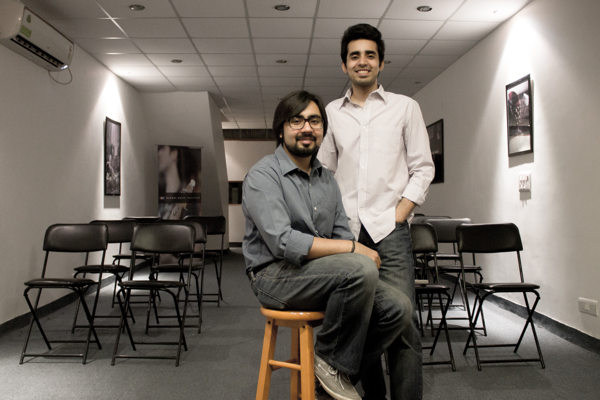
Aditya and Tarun Balani at GMI in Delhi. Copyright GMI; used by permission.
The True School of Music, based in Mumbai, is the newest institution of the three, having had its first intake in August 2013. Audio engineer and SAE graduate Nitin Chandy is the Managing Director, and the school also has links with seminal Mumbai rock venue blueFROG and the Manhattan School of Music. TSM’s facilities are excellent and represent a significant investment including a DJ Room, guitar instruction room, keyboard room, auditorium, and recording studio.
True School of Music offers more options than the other two institutions. A “Foundation” program gives students the option to access staff and work towards Trinity College of Music’s Rock and Pop program. The “Professional” program gives students the option to study performance, DJing, production, and sound engineering. Each of these programs consists of between eight and ten modules, which students can study full- or part-time. Fees for TSM are the highest of the three institutions. A two-semester certificate course consists of between eight and ten courses. At a cost of ₨80,000 per course, a student can expect to pay up to ₨400,000 (US$6,420) per semester.

Facilities at the True School of Music in Mumbai. Copyright True School of Music; used by permission.
There are some common features and challenges in this seminal stage of Indian popular music education, mostly due to the nascent stage of the sector and the difficulty of operating a western music college in a developing economy. Three common areas of operational difficulty are balancing manageable fees with operational viability, the lack of tertiary-qualified music professionals in India, and the accreditation of degree programs.
While the fees for attendance at Indian institutions are lower than in the west, they are high enough to put attendance out of the reach of all except the middle and upper social classes. This is not surprising, as the consumers of Indian rock tend to be western-leaning, English-speaking, and (often) western-educated Indians. A night out watching a live performance can easily cost ₨4,000 or about US$70, comparable with a night out in the west, but beyond the reach of many Indians. Ipshita Roy, a Delhi-based blues singer studying at GMI, observed that studying music in India is
a big investment in terms of their fees. I know for a fact that a lot of musicians who want to study music think twice or thrice about it. GMI is a little more flexible when it comes to that. They give you the option of part-time education. […] While [the courses are] very good, I think there should be something that is more suited to the Indian pocket. That would definitely attract more students. (Ipshita Roy, Personal Interview, Delhi, 21 November 2013)
Roy notes that part-time study is permitted by GMI, and it is also permitted by TSM; however, SAM insists on full-time attendance, presumably because of the difficulty in getting to the campus, which can take three hours from Chennai.
All schools suffer from a lack of local musicians with formal qualifications in contemporary music who can form a faculty. All institutions fly western graduates out for a semester at a time, incurring travel and accommodation costs in addition to salaries. For the Indian classical courses (that only SAM and GMI offer), local musicians are used. While acknowledging that it is a currently unavoidable expense, Balani has plans to ultimately reduce the reliance on foreign-educated faculty.
We’ll bring international faculty until the time we have more graduates like us in the country and there are a lot of people that we have trained, or who’ve gone on full scholarship or partial scholarships to Berklee. When they come back, and we can start to include an academic structure and departments and schools and we can hire local musicians who have the right kind of skill and education. Then eventually we want to stop recruiting internationally full-time. We might do it as a part-time thing. But for the first five to ten years I think the focus will be on bringing international faculty. (Tarun Balani, Personal Interview, Delhi, 15 November 2013).
Lastly, none of these schools offer anything like a degree program. In India, schools do not need to be accredited to offer certificate courses (Nitin Chandy, Personal Interview, Delhi, 19 November 2013), and this is currently the qualification level offered by these institutions. All institutions have an overseas affiliation (SAM with McNally Smith College of Music, GMI with Berklee, and TSM with Manhattan School of Music), and opportunities for articulations are either in place or under negotiation. However, there is also institutional interest in accrediting local degree programs. This process has, in the past, been difficult, but now “all the forms and requirements are already on [the All India Council of Education] website. It says if you offer a bachelors degree, this is how big your school should be, this how big your student body should be, this is the number of faculties you should have, and so forth.” It is, presumably, only a matter of time until locally accredited undergraduate and postgraduate degree programs are available.
As indicated by the title of this article, Indian popular music education is currently building a foundation. Tertiary schools of music exist, though they have been recently set up. Institutions are offering non-formally accredited certificate and diploma programs. Costs are high (for India) at all institutions, however GMI is significantly lower than the other two. Faculty are invariably sourced from overseas due to the problems of sourcing local qualified educators.
However, the contemporary music education sector seems to be increasing its scope and offerings. In the next few years GMI is planning to construct a new campus. Both TSM and GMI hope to employ local graduates as educators, scaling back their international faculty. The coming few years should see degree programs in contemporary music emerge from Indian institutions. It is possible that such institutions will open in other cities and states of India.
The live music scene in Delhi is increasing in significance and size. Large multi-city festivals (such as NH7 Weekender) are offering touring opportunities, and smaller local festivals (such as CelesteFest) are providing local exposure and employment. Venues are opening regularly in South Delhi, Gurgaon and other locations, with two new venues commencing live music offerings during my three-month field trip. Along with these opportunities comes a demand for both talented performers who have the deep knowledge required to perform music, as well as educators to prepare the next generation of musicians. India will shortly become the world’s most populous country, and even if western-influenced Indian rock remains a niche market, a niche market in a country of more than a billion is still sizeable. Contemporary music education in India will need to build on the promising foundation it has constructed.
---
Dr David Cashman is a Senior Lecturer in music at CQUniversity in Mackay, Australia. His research areas include music and tourism (particularly the music of cruise tourism), and popular music in India. David undertook field research in Delhi between September and December 2013 courtesy of research support by Southern Cross University (where he is an Adjunct Senior Lecturer).





